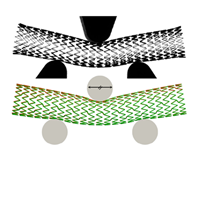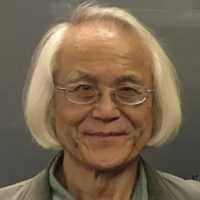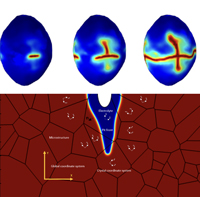events
***Video available*** Severo Ochoa Seminar - "Optimal Local Truncation Error Method for Solution of PDEs on Irregular Domains and Interfaces with Optimal Accuracy and Unfitted Cartesian Meshes", by Alexander Idesman
Wednesday, February 8th, 2023. Time: 3 p.m.
Hybrid - C1-116, C1 building, UPC Campus Nord, Barcelona
Link for online session: https://meet.google.com/qjo-sttx-dgo
ABSTRACT
A new numerical approach called the optimal local truncation error method (OLTEM) is suggested for the solution of partial differential equations (e.g., see [1-4]). Similar to the finite difference method, the structure and the width of stencil equations are assumed in advance.
Discrete equations include regular uniform stencils for internal points and non-uniform stencils for the points close to boundary. The unknown coefficients of the discrete system are calculated by the minimization of the order of the local truncation error. The main advantages of OLTEM are an optimal high accuracy of discrete equations and the simplicity of the formation of a discrete (semi-discrete) system for irregular domains and interfaces (composite materials). For the regular uniform stencils without interfaces, the stencil coefficients can be found analytically.
For non-uniform cut stencils, the stencil coefficients are numerically calculated by the solution of a small system of linear algebraic equations (20-100 algebraic equations). In contrast to finite elements, trivial unfitted Cartesian meshes (no need in complicated mesh generators) are used with OLTEM. Changing the width of the stencil equations, different high-order numerical techniques can be developed. OLTEM does not include unknowns on irregular boundaries and interfaces.
The known interface and boundary conditions at small number of selected points are added to the stencils as the right-hand side. Therefore, the width of non-uniform ‘boundary’ and ‘interface’ stencils is smaller or equal to that for regular stencils. Currently, OLTEM is applied to the solution of the wave, heat, Helmholtz, Poisson and elasticity equations. The theoretical and numerical results show that for the width of the stencil equations similar to that for linear finite elements, OLTEM yields the 4th order of accuracy for the considered scalar PDEs on irregular domains (it is much more accurate compared with linear and high-order finite elements at the same number of degrees of freedom). E.g., 3-D numerical examples on irregular domains show that at accuracy of 5%, OLTEM reduces the number of degrees of freedom by a factor of greater than 1000 compared to that for linear finite elements with similar stencils. At the computational costs of quadratic finite elements, OLTEM yields the 10th order of accuracy for the time-independent elasticity equations and the 11th order of accuracy for the Poisson equation with complex irregular interfaces; see [1, 3]. This leads to a huge reduction in computation time for OLTEM at a given accuracy.
[1]Idesman A. V., Dey B., Mobin M., The 10-th order of accuracy of 'quadratic' elements for elasticheterogeneous materials with smooth interfaces and unfitted Cartesian meshes, Engineering with Computers,2022, pp. 1-25.
[2]Idesman A. V., Dey B., Optimal local truncation error method for solution of wave and heat equations forheterogeneous materials with irregular interfaces and unfitted Cartesian meshes, Computer Methods in Applied Mechanics and Engineering, 2021, 384, 113998, pp. 1-32.
[3]Idesman A. V., Dey B., 3-rd and 11-th orders of accuracy of 'linear' and 'quadratic' elements for the Poissonequation with irregular interfaces on unfitted Cartesian meshes, International Journal of Numerical Methodsfor Heat and Fluid Flow, 2021, pp. 1-27 (accepted).
[4]Idesman A. V., A new numerical approach to the solution of PDEs with optimal accuracy on irregulardomains and Cartesian meshes. Part 1: the derivations for the wave, heat and Poisson equations in the 1-Dand 2-D cases. Archive of Applied Mechanics, 2020, 90(12), 2621-2648.
SPEAKER CV
Dr. Idesman is a Professor in the Department of Mechanical Engineering at Texas Tech University. His research interests include the development of high-order accurate numerical techniques for different PDEs (including wave and heat equations, elastodynamics at low frequency and impact loadings, Helmholtz, Poisson and elasticity equations), the application of numerical techniques to engineering problems. Dr. Idesman has authored and co-authored 107 journal and conference papers. His research was supported by NSF, Army Research Office and the Air Force Office of Scientific Research.





















